String Instruments
Basstarda (Box Electric)
- Cold Cold Ground (Big Time, 1988)
Electric bass, made and designed by Greg Cohen.
TW (1987): "Now, ladies and gentlemen, please direct your attention towards the rear, not exactly the rear, just towards the rear. Ladies and gentlemen, the man in the four dollar jacket, the man that everyone says spends too much money on clothes. Ladies and gentlemen, he's starting to look a lot like Charlton Heston, and that can be a real asset when you're back in the States. Ladies and gentlemen, on the upright bass and the Box electric. He made that little son-of-a-bitch all by himself, from things he found around the house. He calls it the "basstarda". Ladies and gentlemen, the inimitable... Mr Greg Cohen!" (Source: "Big Time" video. Island, 1988)
TW (2004): "That's something Les (Claypool) played. It's like an electric stick with four strings, like a bass without a body. " (Source: "Interview With Tom Waits", by Jonathan Valania. Magnet magazine (UK). October 5, 2004)
C�Mb�S (Cumbus, Chumbus)
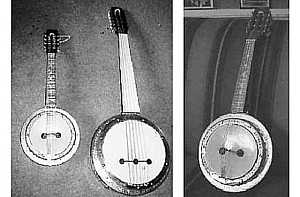
- Low Side Of The Road (Mule Variations, 1999)
The c�mb�s (Cumbus) was invented by Zeynel Abidin Bey who was born in Thessalonika in 1881. Atat�rk listened to Zeynel Abidin Bey playing his new instrument on 24 Janury 1930, and inspired by its exuberant sound dubbed it c�mb�s, a word meaning revelry. The c�mb�s was widely admired and Zeynel Abidin Bey applied for a patent, which was issued after inspection by the Presidential Orchestra Office. The c�mb�s has an attack like a banjo and a long sustain like a Celtic harp. The fingerboard is flat and fretless, usually made of Formica or something similar. Unlike any other stringed instrument, the action is adjustable; the neck is attached to the body by a hinge with a screw that can change its angle.
Q (1999): You use some pretty strange instrumentation here. Where do you find a good chumbus and dousengoni player nowadays? TW: "Oh, that would be Smokey Hormel. He said he was coming up to play on the record and that he was going to bring a station wagon, and I said, "Well, throw some stuff in the back-stuff I've never seen or heard before." [Those are] West African guitars." (Source: "Tom Waits for no man" Time Out New York nr. 187: Brett Martin. April 22-29, 1999)
TW (1999): "I used to see Smokey (Hormel) when he played with The Blasters in Los Angeles. They'd play this little Chinese restaurant, and I'd go see 'em there. And then Larry Taylor said, Let's get Smokey in here. So Smokey came up to the studio and brought in these West African instruments that he played on 'Low Side Of The Road'. They're these strange instruments made out of branches and gourds." (Source: "Mojo interview with Tom Waits" Mojo magazine: Barney Hoskyns. April, 1999)
Dobro
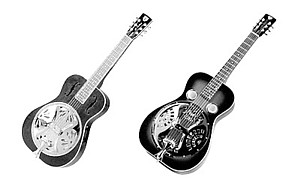
- Pony (Mule Variations, 1999)
The Dobro resonator guitar has been around since the mid 1920's. The Dobro trademark is owned by Gibson. Guitars of this type are referred to as resonator or resophonic guitars. The resonator guitar is popular in contemporary Bluegrass music, adding a soulfull, bluesy touch to the music. Modern country music has rediscovered the resonator guitar after abandoning the instrument for decades. The instrument is available with either a wooden or metal body. Square necked guitars are played horizontally, similar to the steel guitar. The instrument is played with a bar called a steel. Round necked models are played Spanish style, with or without a slide.
PT (2000): "The stark and wistful Pony, mainly just Waits on a pump organ, Smokey Hormel on dobro, and John Hammond on harp (harmonica) is a good example of this natural sound." (Source: "California Screamin'" Audiomedia magazine (UK), by Paul Tingen. February, 2000)
Dozo N'goni (Doso N'goni, Donso N'goni, Doussn'gouni, Dozon N'goni)
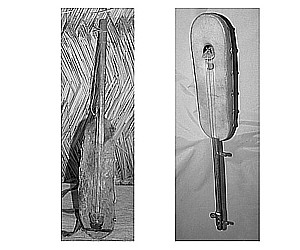
- Low Side Of The Road (Mule Variations, 1999)
The Dozo n'goni (Doso n'goni, Donso n'goni, Doussn'gouni, Dozon n'goni) is a traditional banjo-like lute made from hollowed-out wood with a dried animal skin stretched over it. It has three to five strings and the neck is made from a piece of dowelling. Because the n'goni is a quiet instrument it is now usually played with an electric pick-up. The Dozo n'goni is played by hunters ("dozo" means hunter in Bambara). In Burkina Faso, there is a legend that the n'goni is supposed to have been invented by a Senufo hunter. Since then, the Dozo n'goni has become an instrument used to praise the merits of famous hunters. The n'goni is played by plucking its strings like a guitar.
Q (1999): You use some pretty strange instrumentation here. Where do you find a good chumbus and dousengoni player nowadays? TW: "Oh, that would be Smokey Hormel. He said he was coming up to play on the record and that he was going to bring a station wagon, and I said, "Well, throw some stuff in the back-stuff I've never seen or heard before." [Those are] West African guitars." (Source: "Tom Waits for no man" Time Out New York nr. 187: Brett Martin. April 22-29, 1999)
TW (1999): "I used to see Smokey (Hormel) when he played with The Blasters in Los Angeles. They'd play this little Chinese restaurant, and I'd go see 'em there. And then Larry Taylor said, Let's get Smokey in here. So Smokey came up to the studio and brought in these West African instruments that he played on 'Low Side Of The Road'. They're these strange instruments made out of branches and gourds." (Source: "Mojo interview with Tom Waits" Mojo magazine: Barney Hoskyns. April, 1999)
Prepared Guitar
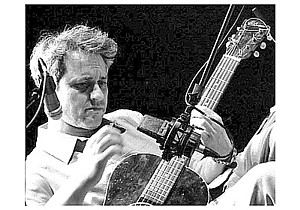
- Marc Ribot, pictured above (Franks Wild Years/ Bone Machine)
TW (1987): "He (Marc Ribot) prepares his guitar with alligator clips, and has this whole apparatus made out of tin foil and transistors that he kinda sticks on the guitar. Or he wraps the strings with gum, all kinds of things, just to get it to sound real industrial."(Source: "Better Waits Than Ever" Music & Sound Output: Bill Forman. Vol. 7, No. 11. October, 1987)
TW (1992): "He's (Marc Ribot) big on the devices. Appliances, guitar appliances. And a lot of 'em look like they're made out of tinfoil and, y'know, it's like he would take a blender, part of a blender, take the whole thing out and put it on the side of his guitar and it looks like a medical show...that look. And the sound seemed to come from, the way it looked and the way it sounded seemed to be the same. (He works with) alternative sound sources, he turns his guitar into an adventure." (Source: "Tom Waits Meets Jim Jarmusch" Straight No Chaser magazine (UK) Vol. 1, Issue 20 Jim Jarmusch. October, 1992 (published early 1993))
Prepared Piano
- More Than Rain (Franks Wild Years, 1987)
TW (1987): "Oh, yeah, a little Edith Piaf attempt (More Than Rain). There's prepared piano on it". Q: How was it prepared? TW: "Lightly sauteed. Francis Thumm plays the strings with a nickel. Almost like you'd play a mandolin. It's in there somewhere." (Source: "From the set of Ironweed, Tom Waits talks with Rip Rense" New York Post: Rip Rense. Early 1987)
Stroh Violin (Stro-Violine)
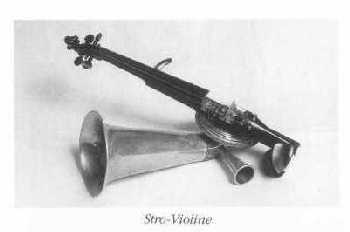
- Gerd Bessler (Alice theatre play, 1992)
- Everything You Can Think(Alice, 2002)
- No One Knows I'm Gone (Alice, 2002)
- Poor Edward (Alice, 2002)
- Lost In The Harbour (Alice, 2002)
- Fish & Bird (Alice, 2002)
- Lullaby (Blood Money, 2002)
- Woe (Blood Money, 2002)
- A Good man Is Hard To Find (Blood Money, 2002)
- David Coulter (The Black Rider theatre play, 2004)
To overcome the lack of carrying power of string instruments, John M.A. Stroh introduced new "violins" in England in the early 1900s. Stroh replaced the violin's usual wooden body with a metal resonator to produce a louder, more penetrating sound. The aluminum horn at the end of the fingerboard directed this sound either into the recording horn or into the ear of the singer. The performer placed the smaller aluminum horn at his or her ear in order to hear what was being played more distinctly
JB (2002): "On the albums (Alice/ Blood Money), the self-described "sound hound" used some odd instruments, including a Stroh violin (a violin with a horn appendage), a calliope (found by his brother-in-law on a flatbed truck in Iowa) and percussive Indonesian seed pods (with seeds the size of grapefruits)." (Source: "Tom Waits peers through the looking glass on two new discs" Star Tribune (USA) by Jon Bream. February/ March. Published: May 5, 2002)
JS (2002): "Recordings of both scores were made only recently, but ''Alice'' - haunting, jazz-tinged, exotic - came first, performed in 1992. Instrumentation includes Stroh violin (a violin affixed with a brass horn), cello, viola, piano, upright bass, clarinet, marimba, saxophone, trumpet, and drums... On ''Blood Money,'' which debuted in 2000, Waits lost the string section but added a 1929 pneumatic calliope - an old circus instrument with 57 whistles - harmonica, and a dried boomerang seed pod from a rare tree that grows only in Indonesia." (Source: "With morbidity on his mind, Tom Waits makes a double play" The Boston Globe (USA) by Jim Sullivan. Published: May 5, 2002)
GK (2002): To give "Alice" and "Blood Money" their distinctive characters, Waits introduced a few more oddities to his sound-making arsenal: a stroh violin (a violin crossed with a brass horn), a pod (a four-foot seed pod from Indonesia, used as a percussion instrument) and a 1929-vintage pneumatic calliope." (Source: "2 albums at once? That's Waits' way Chicago Tribune (USA) by Greg Kot. Published: May 5, 2002)
TW (2002): "The Stroh (violin) is a violin with a horn attached to the bridge. And you know, you're aiming at the balcony and it was designed before amplification so the string players could compete with hornplayers in the orchestra pit... They still make 'em. You know, you can get 'em out of a catalogue. But they're no longer as popular as they were, but they were essential and there were probably fist fights in the orchestra pit before the Stroh. Cause now a lot of people consider 'em obsolete but hey, when I see the word obsolete I get in line."(Source: "Interview with Tom Waits" Triple J's 2002 (Australia) radio show hosted by Richard Kingsmill. Aired: May 12, 2002)
TW (2002): "It's (Stroh violin) a horn attached to the bridge, and it has a hinge on it. It's like a brass flower designed in the same configuration or shape as the old 78 players. You could aim it at the balcony. The string players were disgruntled. They felt they were constantly competing with the brass. It gave 'em a little edge. I don't know, you don't hear it anymore. I guess because before the advent of amplification, you were dealing purely with physics all the time. It's an interesting solution to that problem." (Source: "Tom Waits" The Onion online magazine (USA) by Keith Phipps. Volume 38, issue 20. Published: May 29, 2002)
Viola
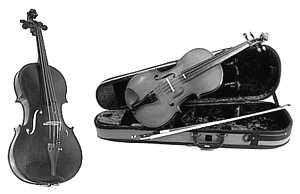
- Henning Stoll (The Black Rider theatre play, 1990)
- Gerd Bessler - Stroh viola(Alice theatre play, 1992)
- The Black Rider (The Black Rider, 1993)
- That's The Way (The Black Rider, 1993)
- The Briar And The Rose (The Black Rider, 1993)
- Crossroads (The Black Rider, 1993)
- Oily Night (The Black Rider, 1993)
- Russian Dance (The Black Rider, 1993)
- Gospel Train (The Black Rider, 1993)
- Poor Edward (Alice, 2002)
- Flower's Grave - Alto viola(Alice, 2002)
- No One Knows I'm Gone - Alto viola (Alice, 2002)
The viola is similar in materials and construction to the violin but is larger in size and more variable in its proportions. Its body length is between one and four inches greater than the violin. The viola's four strings are tuned in fifths: the C an octave below middle C is the lowest, with G, D and A above it. This tuning is exactly one fifth below the violin and one octave above the cello.The viola is the middle-range instrument of the violin family. It is sometimes cavalierly referred to as the "big fiddle." Its position in the violin family somewhat parallels the alto voice of the normalarrangement in a choir of voices. In fact, the French word for viola is l'alto. The viola is played with a bow and placed on the shoulder. In German the viola is the Bratsche, which comes from the Italian braccio, meaning "arm," or to be played on the arm in contrast with being played on the leg. The etymology of the word viola, or viola da braccio, leads some historians to believe that when the violin family emerged as an entity in Italy during the early part of the sixteenth century, the viola may have appeared slightly before the violin, violino being a diminutive form of viola.
TW (1992): "We made a thing the other day that just killed me, all on our feet, okay, you do this, you go, "Vruum, Vruum, Vruuum", made this contra bassoon, bass clarinet, trombone, English horn, French horn, viola, cello - and I feel like a farmer at the opera with these guys. They play everything from John Cage to Mozart and everything in between." (Source: "Telerama Interview" (French promo CD). Date: September 9, 1992)
JS (2002): "Recordings of both scores were made only recently, but ''Alice'' - haunting, jazz-tinged, exotic - came first, performed in 1992. Instrumentation includes Stroh violin (a violin affixed with a brass horn), cello, viola, piano, upright bass, clarinet, marimba, saxophone, trumpet, and drums... On ''Blood Money,'' which debuted in 2000, Waits lost the string section but added a 1929 pneumatic calliope - an old circus instrument with 57 whistles - harmonica, and a dried boomerang seed pod from a rare tree that grows only in Indonesia." (Source: "With morbidity on his mind, Tom Waits makes a double play" The Boston Globe (USA) by Jim Sullivan. Published: May 5, 2002)
Wind Wands
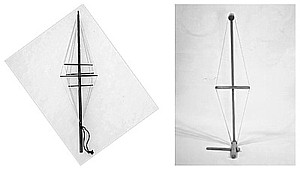
- Alice theatre play rehearsals, 1992
- Also featured on Moanin' Parade & Swarm Warnings (Gatmo, 2000)
Wind Wands (invented and manufactured one-of-a-kind by Darrel DeVore) produce the buzzy bass of a light saber when sliced through the air or twirled. They're constructed of wooden dowels, hand-carved adjustable bamboo bridge, and thick vibrating rubber-bands. Others also claim to be the inventor of the Wind Wands.
RR (1992): "Moments prior to this interview, Waits was packing his suitcases with socks, underwear - and experimental musical instruments called Wind Wands, photon clarinets, PVC Membrane saxophones, a Waterphone and something called a T-Rodimba... The "Alice" instruments, Waits excitedly points out, were built by "real pioneers" of music living in the Bay Area: Richard Waters (the Waterphone, a polytonal metal instrument filled with water), Tom Nunn (the T-Rodimba, a conglomeration of plywood and hardware with a violin pick-up), Darrel DeVore (Wind Wands, "which sound like Orville and Wilbur"), Bart Hopkins (PVC Membrane saxophones, which are too complex to explain succinctly) and Reed Ghazala (photon clarinets, which are played by beams of light bouncing off light-sensitive keys)." (Source: "Waits in Wonderland" Image: Rip Rense. December 13, 1992)

